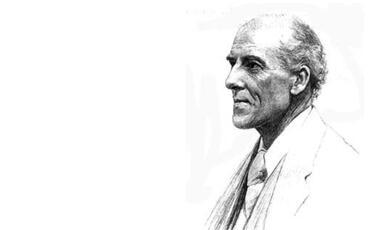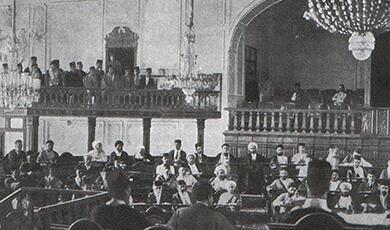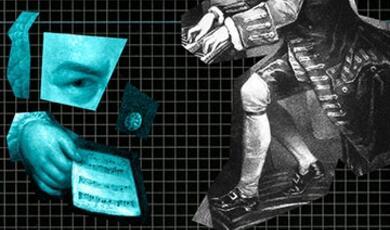Ancient Goddesses of Sex and War
Share
- Details
- Text
- Audio
- Downloads
- Extra Reading
This lecture looks at a series of divine female figures in the ancient world from the Middle East to Western Europe: Inanna, Ishtar, Astarte, Aphrodite and Venus. What they have in common, is that to varying degrees they all combined the personae of deities of sexual love and of war. It brings out the special characteristics of each, traces the relationships between them, and shows how each in the sequence, influenced the development of the next.
Download Text
Ancient Goddesses of Sex and War
Professor Ronald Hutton
20 September 2023
Divine Character Development
Some ancient deities never developed, meaning that they stayed more or less the same beings throughout their recorded history. Others, however, have biographies, in the sense that they evolve significantly in character and function, and that process can be studied. Some influenced others and contributed to their evolution. What I want to do in this talk is to look at a set of such deities, and their relationships with each other. They are a clearly defined group of Mediterranean and Near Eastern goddesses, who have discernible connections with each other. They also, to varying extents, share the characteristic, counter-intuitive to modern sensibilities, of being associated with both love – or at least sex – and war. I shall start the sequence with Inanna, one of the earliest goddesses recorded in Mesopotamia, modern Iraq.
Inanna
Origins
By the time she emerges into literature, in the late third century BCE, Inanna is already a complex figure, with a long development behind her. Scholars like Thorkild Jacobsen have proposed that the goddess we meet at this time is a composite of different qualities which derive from different earlier periods. They can thus be distinguished, like layers of deposit on an archaeological site. This is probably true, and the following sequence of development has been proposed for Inanna. She seems to begin as the goddess who protected the agricultural storehouse: the barn. This would make her immediately a major deity to the communities of ancient Sumer, the farmlands of southern Mesopotamia, which depended on the produce of agriculture to survive. Its continued preservation, between harvest and consumption, was therefore a vital phase in the economic process. It deserved an appropriately important patroness, and Inanna got the job. This original function of hers was underlined by marrying her to Dumuzi, the local god responsible for the fertility of the farmlands. In other words, Dumuzi generated the farm products and Inanna then looked after them: the perfect divine economic partnership. The first religious rites to them seem to have been dedicated to thanking them for their bounty and encouraging them to provide more and better.
This provision became more important during the fourth millennium BCE, as cities grew up on the rich produce of the Sumerian plain and their increasing populations needed to be fed. One of the most famous of the ceremonies to encourage it which survived into the historical record was that in which the king of a city symbolically wed the goddess. A text has survived from the city of Nippur, celebrating the union of Inanna and Dumuzi, which may have been part of that ritual. It consists of a dialogue between goddess and god and has a delightfully frank sexuality. In it, Inanna describes her body’s ‘barge of heaven, crescent-shaped, like the new moon’, her ‘untilled plot of land, long left fallow in the desert’, her ‘duck field, think with birds’, her ‘hillock land, so verdant’, her ‘lovely farmland, banked around’. She calls on Dumuzi to ‘put his plough’ to her ‘well-watered lowlands’.
Development
Later, as an extension of her role as guardian of abundance and wife of a major fertility god, she seems to have become a goddess of rain and of the thunderstorms that commonly bring it to the Mesopotamian plain. Power over thunder seems to have led her to become one of the Sumerian war goddesses, so that battle was sometimes nicknamed the ‘dance of Inanna’. The combination of receiving the power of the fertility god into her body and filling men with battle fury seems to have given her an additional role as goddess of sex. As such, she became a goddess delighting at once in sap, sweat, semen, blood and all the other vital fluids and forces of passion and ecstasy. That is probably why she became associated with the planet that we call Venus: when it rose in the morning she called soldiers to arms, and in the evening, she called lovers to each other’s arms. One of the surviving Sumerian hymns to her has her speak in her fully developed form as ruler of heaven and earth, delighting in battle, flood, and hurricane. She is called a falcon while other deities are sparrows, as free and powerful as a wild cow on the plain.
All this process of accretion probably took between two and three thousand years, and by the time it was complete, by the end of the third millennium BCE, she had made a further development, by becoming a personality. By the middle of that millennium, Sumerians had started to put their various deities into family relationships and tell stories about these. This was a natural theological consequence of the key political development of the period: the unification of the previously independent and mutually hostile Sumerian cities into a single empire. The character given to Inanna was unique to her, and one of the most colourful and strongly marked of all: she is a beautiful, sexy and highly sexed, spoiled, stroppy, bolshie and imperious young princess. In short, she is in trouble. She appears in stories in all the roles which a woman is capable of taking except those which involve stability and duty. She is never ever a loyal and supportive wife or a mother.
The Descent
The most famous of all the stories concerned is that of the Descent of Inanna, which is, like so much ancient mythology, about deities behaving badly. Inanna is, as usual, not so much the heroine as the antiheroine. She decides to visit the underworld, the realm of a different goddess, Ereshkigal. She seems to go purely out of curiosity. In doing so she breaks a cosmic rule by going where she has no business to be. As a result, she ends up trapped there, effectively dead. The result is a massive disturbance in the natural order of things, in which none of the major deities acquit themselves very well. In the end, Inanna gets out by arranging for her faithless husband Dumuzi to take her place in the underworld, at least for some of the time.
Ishtar
Inception
Inanna now commenced a series of apparent migrations into other goddess forms. The first was the easiest, because it involved mostly just a change of name, into Ishtar. This was the consequence of a political change, the conquest of Sumeria by another Mesopotamian people, the Akkadians. Ishtar was their main goddess, who became merged with Inanna after the conquest occurred. The composite deity resulting retained her Akkadian name when she was taken on by still more powerful Mesopotamian conquerors in later millennia, the kings of Babylonia and Assyria. She underwent some subtle changes in the process. Her iconography became more standardised, with the lion as her particular symbol, reflecting her fierce nature. She also grew into a still greater goddess. In Sumeria, although one of the main female deities in the pantheon, she had specific local roles: in particular, she was the patroness of one city, Uruk. In Akkad, Babylonia, and Assyria, she became at times the leading goddess of the whole kingdom. In literary personality as in attributes, however, she was still our same old Inanna. Indeed, Akkadian translations of Sumerian stories just changed her name to Ishtar, and nothing else.
Ishtar and Gilgamesh
Her longest and most vivid appearance in an Akkadian text is in the most famous of all, the Epic of Gilgamesh, put together by a Babylonian writer in the second millennium BCE from a variety of earlier Sumerian stories. In it, Ishtar alias Inanna is her usual magnificent and appalling self. She starts by propositioning the hero Gilgamesh, on his return from an expedition which has established him as the leading king in Sumeria. She asks him for the ‘seed of his body’, and in return promises a chariot of gold, lapis lazuli and copper, drawn by storm demons. Also, a perfumed palace in which other rulers do him homage and bring tribute, and superlative fecundity for all his livestock. Note that she is offering him status, power, and wealth, starting with the Sumerian equivalent of a Porsche Turbo. The great sex is taken more or less for granted. Evidently to her amazement, and perhaps to ours, he refuses. He itemises in insulting detail the way in which he has disposed of all her previous husbands – starting with Dumuzi – as soon as they had bored or displeased her. The reaction of ‘glorious Ishtar’ to this is to fly into a ‘bitter rage’ and run straight to her parents to ask for vengeance on Gilgamesh. Daddy unhelpfully points out that everything the hero has said about her was in fact perfectly correct. Ishtar cheerfully admits that her conduct has consisted of ‘abominable behaviour’ and ‘tainted acts’. Her point is that it is irrelevant because mortals shouldn’t insult a goddess. Her next move is effectively to throw a tantrum, in which she demands that her father give her free use of a cosmic monster, the ‘Bull of Heaven’, to destroy Gilgamesh. If he refuses, she threatens to smash the doors of the underworld and let the dead loose upon the living, so wrecking the terrestrial world. Her weary father objects that to let loose the monster will itself destroy the crops and cause famine. Ishtar brightly replies that she has foreseen this and laid up stocks of food to cover the time till the devastation passes. She is clearly a lass who plans vengeance well ahead. Everybody loses by the result. Gilgamesh and his best friend succeed in killing the great bull and thwarting Ishtar yet again, but the friend dies as a result and rips out the emotional centre from the hero’s life. Ishtar does not, however, function in Mesopotamian literature merely as a super-brat, a kind of ancient forerunner of Joan Collins. Like other major deities, she came by the second millennium to act as a personal patroness to individual humans, who cared about them deeply and was expected to respond to their prayers.
Ishara and Astarte
Ishara
Ishtar’s cult spread very far across the ancient Middle East, so that by the second millennium it was found across the whole of Mesopotamia and as far west as Syria and Asia Minor. As she moved into those western regions, she became associated with two other major goddesses. One had a very similar name, Ishara, and was effectively the same being, with the same mythology. She also kept the same husband, Dumuzi, now called Tammuz, with the story of their descent into the underworld. In these western lands, where seasons were more strongly marked, that story became more straightforwardly an explanation for summer and winter. It was the Near Eastern equivalent to the Greek myth of Persephone, and perhaps part of the inspiration for it. In Syria and Palestine, however, the impact of the seasons is reversed. Winter is the time of rain, and so of greenery, and summer is the time of death, when vegetation is scorched up. Women would therefore weep for Tammuz’s departure at the opening of summer.
Astarte
Ishara was however only one dimension of Ishtar and Inanna. She represented her as the goddess of love and sex, but not of war and rulership. That aspect was taken on by another Syrian goddess, Ashtar or Ashtarte, known in English as Astarte. Like Ishara she is a young and sexy goddess, but also a huntress and much more concerned with war and government. As a virgin huntress, she seems at first like the Greek Artemis, but she marries Baal, the horned sky and weather god, and they have various adventures together. In the Syrian Epic of Keret, she is described first as a huntress, slaying a wild bull for her divine father to eat, and then as dressed in cypress-wood armour with a linen dress beneath, and having a sheen of beauty like desert stars. It goes on to describe how this beauty won the heart of Baal. So, Astarte is not the same kind of deity as Ishtar but shares some of her functions. It is as if in Syria and Palestine the duties of Ishtar were divided between two different divine females.
Iconography
Those lands also made one further distinctive contribution to the image of this kind of goddess: that she gets her kit off. Syrian goddesses of the second and first millennia BCE were often portrayed nude, facing the observer with upraised hands. Mesopotamian goddesses had traditionally been depicted robed in art. In this later period, however, the Syrian style of nude icons made an appearance there as well. The most famous depiction of a naked goddess from both regions is also the most enigmatic.
This is the Burney Relief, commonly called the Queen of the Night, which has long been deposited in the British Museum and recently been acquired by it. There is nothing else quite like this image in the whole of Mesopotamian and Syrian art. She was long thought to be Lilith, the nocturnal demoness who kills babies, but Lilith, Lilitu in Mesopotamia, was never a goddess. This lady is a super-goddess, because of the number of horns on her headdress. Others thought that she might be the goddess of the underworld, Ereshkigal, Inanna’s nemesis in the myth of the descent. Ereshkigal, however, has absolutely no known icons or temples. She does not in fact seem to have been worshipped by the living at all. My own opinion is that she is actually our very own Ishtar, alias Inanna, rendered in the style of a Syrian goddess. She stands in the same posture, holding Mesopotamian symbols of majesty. She stands on lions, as Ishtar-Inanna does, and has clawed feet like some of the Syrian goddesses in this posture. The owls could be there to indicate her identity as the Evening Star, bringing night.
Aphrodite
Origins
So, it could be argued that concepts of deity across the whole of the ancient Near East influenced each other, but I am more interested, in the second half of this talk, in their impact upon Europe. This, of course, is where we come to Aphrodite. All scholars agree that she was a latecomer to the Greek world. Unlike the majority of deities in the classical Greek pantheon, she is totally missing from the inscriptions on the Linear B tablets compiled between the 15th and 13th centuries BCE. On the other hand, by the time of Homer in the 8th century, she is fully integrated into the Greek divine family. So, she appears in the gap, of half a millennium from which no written records survive.
This conclusion is one with which the Greeks themselves would have agreed. Both they and the Romans emphasised that the cult of Aphrodite had arrived in Europe from the east. She was essentially a foreign goddess. Furthermore, they were conscious of the staging posts by which she had made the crossing from Asia to Europe: the islands of Cyprus, Crete, and Cythera. Above all, it was Cyprus, the big island nearest to Asia, which produced Aphrodite in her enduring form and was always regarded as her true home.
She was indeed a native Cypriot goddess, though nothing like Inanna. Her icon from her main cult centre on the island, of Paphos, has survived, because it looks nothing like a goddess. It is a large and shapeless hunk of rock. One of the natural riches of Cyprus is copper, a vital ingredient in the bronze which made the Bronze Age possible. Aphrodite seems to have got started as the goddess of mineral-bearing rocks. This would explain a trio of puzzles about her. The first is that her original Cypriot name was Kypris, echoing the name of the island as if she represented the land itself. The second is why this most gorgeous of goddesses is married, in Greek mythology, to the decidedly not gorgeous smith god Hephaestus. The third is why she is repeatedly called ‘golden’ in ancient texts. This reflects of course on her charisma and allure, and the Greek penchant for blondes, but also on the literal appearance of some kinds of copper ore, and smelted copper.
Nonetheless, this literal rock chick seems to have got transformed into the Aphrodite we all know by the arrival of Ishara and Astarte from Syria. Stephanie Budin has shown how from 1200 BCE images of naked goddesses of the Syrian kind were appearing in Cyprus at a time of close contact between the island and the Syrian mainland. It is from this time that Aphrodite’s original cult centre at Paphos shows continuous occupation and development. This pattern may also explain another aspect of her myth: the image of a beautiful naked goddess arriving out of the sea. She had effectively done that by crossing over to Cyprus from Asia.
There was a further direct connection between Aphrodite and Inanna, and that is the myth of the former’s love for a handsome mortal, Adonis. In the story, Adonis is killed, and Venus and her human worshippers, especially women, mourn him ritually ever after at the beginning of summer. Adonis is simply the Greek version of the Syrian and Palestinian ‘Adonai’, meaning lord. He is none other than our old friend Tammuz, alias Dumuzi, and the rites of mourning were copied from those of Tammuz in Syria and Palestine.
Nature
Nonetheless, Aphrodite was not the same sort of goddess as Ishtar or Inanna. She was not widely associated with war or government, although she was a war goddess in a few places in the Greek world, such as Sparta. Indeed, Homer made great play with the fact that she was not at home on the battlefield. He gleefully portrayed what happened when she intervenes to stop the Greek hero Diomedes from killing her own son Aeneas, whom she has borne to a Trojan prince: Diomedes spears her through the hand, sending her off weeping while he insults her as having no place in a battle. Having done this, he gets off scot-free. He does so partly because he is protected by a thoroughly warlike goddess, Athene, who hates Aphrodite, but also because the clash of steel is not Aphrodite’s milieu.
In harmony with this lack of a military or regal role, her chosen animal is not the lion but a range of birds, specifically doves, swans, geese, and sparrows. Nor was she linked to the morning or evening star. She was closely associated with minerals, as said, and also with the sea, her mythological birthplace. Her symbol is the cockle or scallop shell. She also became connected to flowers, especially roses, perhaps because fragrance was one of her alluring personal characteristics. She was, above all, the deity of sexuality and love, thereby representing half of Inanna’s attributes. The Greek word ‘aphrodisia’ simply means to make love. She is not a mother goddess or much concerned with human or animal fertility: her province is simply the power of love and the joy of sex. The Homeric Hymn to her credits her with stirring up ‘sweet desire’ in deities, humans, and beasts alike, and causing them to mate.
The Greek Attitude to Love
It is worth pointing out that the Greeks were not convinced that love was necessarily a good thing. Our own culture tends the think that it is, for two reasons. One is the modern emphasis on choice, spontaneity, and response to natural impulses. The other is the massive influence of Christianity, which harped on the Greek word that the English translate as love, agape, as the controlling and animating power in the cosmos. On the other hand, Christians were much less keen on sex and tried to separate it from love. Jehovah is remarkable as an ancient god who never apparently has sex. Inanna and her related goddesses, by contrast, were normal for ancient deities in enjoying sex a lot themselves, as well as instigating it in others.
The pagan Greeks, and after them, the Romans, distinguished three human impulses within what we normally call love: sex, affection, and passion. They were generally positive about the first two. Some mystics preferred celibacy as a way of shaking off the distractions of the world. Many people thought that a real man should be an active partner in lovemaking, whether heterosexual or gay. Nevertheless, they recognised that sex was a pleasure as well as a means to children, which could be employed in all sorts of different ways. They also saw it as a superlative reinforcement to, and expression of, emotional attachment.
What they also saw, starkly, was that it is often bad for both the individuals concerned and the groups with whom they are involved when people lose control of their emotions by falling passionately in love with somebody. They admitted, moreover, that this was something which could occur without warning, and was completely irresistible even by the most sensible of people. That is why Aphrodite, like Inanna and her sister (or daughter) goddesses, was scary. One of her titles was ‘merciless’.
That is why love is the villain of the piece in most heroic literature. It is Ishtar who ruins the happiness of Gilgamesh in revenge for his rejection of her, and Aphrodite who causes the Trojan War. It is also love that wrecks the fellowship of the Round Table and the Irish Fianna and turns King Mark against his nephew Tristan. To the Greeks, eros, passionate, infatuated, love, was simply the most frightening force in the world next to Thanatos, death. It was awe-inspiring in the way in which a thunderstorm or an avalanche is awe-inspiring. The Greek playwright Sophocles described Aphrodite as ‘raving madness’, ‘lamentation’, and ‘all that leads to violence’ as well as tranquillity. The greatest of the gods cannot withstand her powers, and she puts the plans of divinities and humans alike into chaos.
Iconography again
One departure that the Greeks made when receiving Aphrodite is that, in contrast to the peoples of the Near East, they didn’t like showing goddesses as nude. Thus, Aphrodite was depicted as robed for the first four hundred years in which she appeared in Greek art. This tradition was overturned in the fourth century, apparently because of a remarkable woman called Phryne, a high-class courtesan living in Athens. We know two things about her. One is that she prepared herself for initiation into the mysteries of Eleusis by bathing nude in the sea, in public and in daylight, instead of waiting for nightfall as other pilgrims did. The other is that she was subsequently tried at Athens for blasphemy, the penalty for which was death. She was tried in the same court as that in which the philosopher Socrates had been condemned a few decades before, but she was acquitted.
Later Roman legend had it that she informed the judges that she was dedicated to Aphrodite and the pursuit of love. She invited them to decide if she seemed fitted for it and disrobed to stand naked before them. The judges (all of course male) then declared her guiltless. We shall never know what really happened in that courtroom. What is for sure is that two great artists then produced works in which Aphrodite herself was portrayed nude and that each of them was allegedly inspired by Phryne and used her as the model. One was Apelles, a painter, who portrayed the birth of Aphrodite from the waves. The other was Praxiteles, a sculptor, who created for the city of Cnidos a statue showing the goddess disrobed to bathe. From that point onward, it became customary across the Greek world to represent Aphrodite as nude in art, and the Romans took over that tradition for their goddess, Venus. Behind the whole of this enduring Western tradition may lie one courageous woman.
Phryne went on to become a millionairess and was given a statue, as a heroine, at the great Greek cult centre of Delphi. When the walls of another major city, Thebes, were destroyed by an earthquake, she allegedly offered to pay to have them rebuilt. However, she had a condition. The original walls were said to have been built by the hero Heracles. Phryne wanted an inscription on the new construction, reading ‘Boy power put these walls up; girl power had to put them back again.’ The Thebans refused.
Venus
Origins
I have now mentioned Venus, as the Roman equivalent to Aphrodite, and we must end this journey with her, in western Europe. Once more, the goddess concerned turns out to be a more complex and interesting figure than has often been thought. Venus begins, way back in archaic Roman history, as a sexless spirit who looked after cultivated gardens. Her vital role in that regard was to care for that vital economic component, the vegetable patch. She thus begins her career as a non-gendered divinity of cabbages, beans, turnips, etc. This fact, incidentally, explains what is otherwise a linguistic conundrum: that this most rampantly feminine of Roman goddesses has a name which is a neutral noun. Early in Roman history, this spirit became merged with a now-forgotten Etruscan goddess, when Rome conquered the Etruscans. She was Turan, the patroness of flowers. The common interest in gardens brought them together.
Venus now became thoroughly feminine and physically pretty. This and her association with flowers, especially roses, made her the obvious match in the Roman pantheon for Aphrodite. The two became merged when Rome absorbed Greek culture wholesale from the Greek colonies in Italy and conquered those colonies. The Romans took over Greek deities by giving them Roman names, and by 200 BCE were translating their myths. Venus was simply given all of Aphrodite’s deeds and relationships, and Aphrodite’s iconography, including that modelled on our friend Phryne.
She was never, however, quite the same as Aphrodite, for she lacked the Greek goddess’s connection with the sea and rocks, though she did take the association with copper. Moreover, her connection to flowers and greenery was even stronger. There is a wonderful evocation of her in that role in a poem called the Pervigilium Veneris, the Night-Watch of Venus, composed in the imperial Roman period. It describes how she calls forth the green summer foliage and opens the rose buds bids them bloom, and likewise calls all lovers to commence or continue affairs with each other.
Moreover, unlike Aphrodite, Venus continued to develop in the late antique period. In particular, during the first half of the final century BCE, her image took a quantum leap. She suddenly became a goddess of war as well as of love, presiding over life and death. She also became associated with the planet which has ever after borne her name in the Western world. What had seemingly happened was that the Roman Empire had reached the Near East, and so connected with the worship of Ishtar alias Inanna, and goddesses influenced by her, which had now been conducted there for thousands of years. The Romans were so impressed that they gave their nature and powers as well to Venus. In the process, she became the last and greatest of Inanna’s daughters.
As a result, by the imperial Roman period, the worship of Venus was divided into four aspects, extending in festival terms from April to August, across the season of flowers. First, she was honoured as Venus Obsequens, the easy-giver, provider of the pleasures of life, and especially of the body. Then she was celebrated as Venus Genetrix, the animating force of vegetation, and especially of flowers. Next, she became Venus Victrix, the mistress of life and death, and giver of victory in war. The Roman soldiers who conquered Gaul and Britain used her name as their battle cry, but her military role was just one aspect of her powers as a stirrer of sap, sperm, blood, and the juices of libido: the forces of life itself. Finally, on 19 August, she had her festival as Venus Libitina, the giver of death, who was portrayed in a chariot drawn by mice. The funeral directors of imperial Rome were all dedicated to her and kept her feast. By the imperial period, moreover, extensions from these qualities had given her eight more responsibilities, including, by various leaps of logic, chariot-racing, and the sewer system.
Furthermore, whereas Inanna and Ishtar disappeared from living tradition at the end of the ancient world, until rediscovered by archaeologists, and Aphrodite was known only to a small literary elite, Venus remained a major figure in European culture. In her developed, imperial Roman, form, she was carried all over the Western half of the empire and continued to feature in art and literature ever after. To illustrate this, I close not with an ancient invocation to her, but as one to her as the classical goddess and planetary deity, composed by the Renaissance Italian philosopher Giordano Bruno:
‘Venus, known as The Lady, nourishing one, gorgeous one, queen of beauty, handheld in darkness, warmest of hearts, generous one, honey woman, giver of sweet madness, shining one, star woman, treasure made flesh, perfumed one, playful one, foam born and fertile, golden-handed, silver-worded, delight of all the senses, flame of the night’s ending, brilliance of the evening, passion-blender, giver of the storm of love, giver of the peace of love, hear me, heal me, hold me.’
© Professor Ronald Hutton 2023
References and Further Reading
Jacobsen, Thorkild. The Treasures of Darkness. 1978
Sugimoto, David. T., ed. Transformation of a Goddess. 2014.
Budin, Stephanie Lynn. The Origin of Aphrodite. 2003.
Cyrino, Monica S. S. Aphrodite. 2012.
References and Further Reading
Jacobsen, Thorkild. The Treasures of Darkness. 1978
Sugimoto, David. T., ed. Transformation of a Goddess. 2014.
Budin, Stephanie Lynn. The Origin of Aphrodite. 2003.
Cyrino, Monica S. S. Aphrodite. 2012.
This event was on Wed, 20 Sep 2023
Support Gresham
Gresham College has offered an outstanding education to the public free of charge for over 400 years. Today, Gresham College plays an important role in fostering a love of learning and a greater understanding of ourselves and the world around us. Your donation will help to widen our reach and to broaden our audience, allowing more people to benefit from a high-quality education from some of the brightest minds.


 Login
Login







